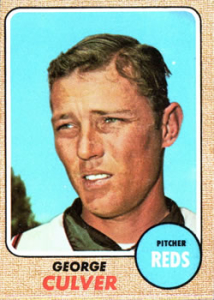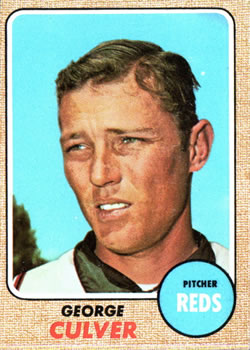July 29, 1968: 27 outs, 7 baserunners, and 1 run: George Culver labors through no-hitter
 George Culver was feeling sick. “I had an upset stomach,” said the 25-year-old right-hander in his first season with the Cincinnati Reds. “I felt lousy, real weak and listless.”1 Not only bothered by nausea and a loss of appetite, the converted reliever suffered from a terribly ingrown toenail. I had to get a shot of Novocain before I could put my shoe on.”2 Culver was scheduled to start the second game of a twin bill against the Philadelphia Phillies, but wasn’t sure if he could. “I didn’t warm up long,” he recalled. “I didn’t feel good warming up.”3 The final result was the best game of his career.
George Culver was feeling sick. “I had an upset stomach,” said the 25-year-old right-hander in his first season with the Cincinnati Reds. “I felt lousy, real weak and listless.”1 Not only bothered by nausea and a loss of appetite, the converted reliever suffered from a terribly ingrown toenail. I had to get a shot of Novocain before I could put my shoe on.”2 Culver was scheduled to start the second game of a twin bill against the Philadelphia Phillies, but wasn’t sure if he could. “I didn’t warm up long,” he recalled. “I didn’t feel good warming up.”3 The final result was the best game of his career.
Skipper Dave Bristol’s Reds were beginning to click on all cylinders as they arrived in the City of Brotherly Love to kick off a three-game, two-day series against the Phillies. The team had won seven of its last nine games to move above .500 (49-47) and into third place, yet trailed the streaking St. Louis Cardinals by 14½ games. After a franchise-record six consecutive winning campaigns, the sixth-place Phillies (48-51) were rapidly sinking into irrelevance. They had won their last two games, mercifully ending a nine-game losing streak for manager Bob Skinner, the team’s third pilot of the season.
Connie Mack Stadium, the deteriorating, one-time jewel and first modern steel-and-concrete ballpark in the US, drew a crowd of 14,083 for a Monday evening doubleheader, considerably more than the Phillies’ NL-low season average of 8,204. Skinner’s squad showed some resiliency in the first game, overcoming a 6-3 deficit to tie game in the eighth, before Pete Rose tripled and scored the go-ahead run in the ninth. Charlie Hustle, playing right field, ended the game when he fielded Johnny Callison’s single and fired a strike to home plate and nailed Dick Allen.
Scheduled to start the second game, Culver arrived during the middle of the first contest and tried to conserve his energy. An offseason acquisition in a multiplayer trade with the Cleveland Indians for Reds speedster Tommy Harper, Culver had appeared in 53 games in 1967, but only once as a starter. He emerged in ’68 as one of the Reds’ most effective starters, sporting an 8-9 slate (3.02 ERA). His opponent was Chris Short, a 30-year-old southpaw and workhorse who had won 20 games two years earlier. He owned a stellar 2.66 ERA, despite a 9-10 record that pushed his career numbers to 105-93.
After the Reds left two on in the first, a wobbly Culver took the mound. Leadoff hitter Tony Taylor smashed a hard-bouncing grounder that seemed destined to get past shortstop Woody Woodward. The versatile infielder, acquired in early June from the Atlanta Braves, made a quick move to his left, reached the ball, and then made an off-balance throw which, according to sportswriter Allen Lewis of the Philadelphia Inquirer, Don Pavletich scooped out of the dirt.4 That sequence proved to be the defensive gem of the game and one of just two hard-hit balls by the Phillies.
In the bottom of the second, Phillies enigmatic star Dick Allen led off with what Phillies beat reporter Bill Conlin of the Philadelphia Daily News described as a “twisting short hop” to third base which Tony Perez fumbled.5 Woodward snared the carom and threw wildly over Pavletich’s head and Allen was standing on second courtesy of the two errors. “It hit the heel of my glove,” explained Perez. “It was a tough play, but I am supposed to make tough plays.”6 After Don Lock walked with one out, Cookie Rojas’s sacrifice fly drove in Allen.
Rose, who began the day as the NL’s second leading hitter (.326), led off the third with a single and tied the game when the league’s third-leading batter, Alex Johnson doubled. Consecutive two-out walks to Perez and Pavletich filled the bags. Pat Corrales, promoted from Triple-A Indianapolis about two weeks earlier, hit a grounder that “dribbled off [shortstop Roberto] Pena’s outstretched glove,” wrote sportswriter Bill Ford of the Cincinnati Enquirer, enabling Johnson and Perez to become Corrales’ first two RBIs as a Red.7
“I was thinking about [a no-hitter] from the third on,” admitted Culver. “I looked up and saw the scoreboard with one run and no hits and thought it would be unusual if I could get a no-hitter with run scored.”8 Culver might have also wondered if he would escape the inning when his road roommate Corrales was called for catcher’s interference with Short at bat to put the leadoff man on, the Phillies’ fourth baserunner. Three straight routine grounders ended the frame.
The Reds were a powerful offensive team in ’68, and eventually led the majors in scoring (690 runs) and batting average (.273), and they could see Short didn’t have his best stuff. In the fourth, Rose, Tommy Helms, and Johnson strung together one-out singles resulting in another run. After May drew a one-out walk to load the bases, Pavletich sliced a two-run single to give the Reds a 6-1 lead and send Short to the showers.
While Phillies relievers Gary Wagner (4⅓ innings) and Turk Farrell (1 inning) did their part by shutting down the Reds the remainder of the game, yielding just three hits, the Phillies couldn’t solve Culver, though he gave them some chances.
Culver had retired 11 straight batters when “the pressure began to mount in the sixth,” wrote Ford.9 The 6-foot-2, 185-pound Californian issued consecutive two-out walks to Callison and Allen, but used his heater to fan five-time St. Louis Cardinals All-Star Bill White to end the threat.
Bill Conlin reported that Culver exhibited “ragged control” and ran deep counts all game.10 The hurler’s wildness flared up again in the eighth; he issued leadoff walks to Gonzalez and Taylor. Skipper Bristol motioned for reliever Clay Carroll to start warming up and made a slow trek to the mound. “I don’t really remember what he said other than if I was tired. I said, ‘Hell no,’” quipped Culver after the game.11 “I just tried to calm him down,” retorted Bristol, a hothead skipper, just 35 years old. “I didn’t know what to tell him. I’m not that smart.”12 Culver retired the next two batters, then got a scare when Allen hit a hard liner, the first ball that remotely resembled a hit since Taylor’s leadoff grounder. Two-time All-Star second baseman Tommy Helms knocked it down, scooped it up, and tossed to first to just beat Allen to end the inning.
“I was determined that if they were going to get a hit, it was going to be on a good pitch,” said Culver about starting the ninth inning. “I was giving ’em all breaking stuff even though my fastball was working good.”13 Culver and Corrales agreed to go exclusively with sliders and the plan worked to perfection. White swung at the first pitch and grounded to Pavletich, then Lock sent the second pitch back to the mound, a feeble grounder for a 1-3 putout. Culver needed just one more out to complete the Reds first no-hitter since teammate Jim Maloney’s 10-inning, 10-walk victory over the Chicago Cubs at Wrigley Field on August 19, 1965, and the first at Connie Mack Stadium since the Los Angeles Dodgers’ Sandy Koufax turned the trick on June 4, 1964. To the plate stepped Rojas, the Cuban-born infielder who began the day batting just .239. “I was afraid of [him],” said Culver, perhaps with a flair for the dramatic. “He has hit me pretty well in the winter leagues. As a matter of fact, he once was my manager in Puerto Rico.”14 After swinging and missing on Culver’s first pitch, Rojas took a half-swing, according Ford, on the second offering and popped up to Pavletich.15 The first baseman corralled the ball, ensuring Culver’s no-hitter, and ending the game in 2 hours and 43 minutes.
What followed was a “near mob scene,” opined Ford. Corrales sprinted to the mound to congratulate his pitcher, while teammates spurted from the dugout for a group celebration.16 Many Phillies fans, who had been cheering enthusiastically since the eighth inning for Culver to make history, bolted over barriers and rushed on the field.
Culver faced 34 batters, retired 14 of them on groundballs, fanned four, and walked five in what proved to be the best-pitched game of his big-league career. Basking in the afterglow of his accomplishments for a few days, Culver came back down to earth, losing his next three starts and seven of his last nine decisions to finish the season with an 11-16 record and 3.23 ERA in 226 innings. The following season, he served as a swingman, then moved into a full-time relieving role in mid-1970, spending his final five seasons with four different clubs.
SOURCES
In addition to the sources cited in the Notes, the author accessed Retrosheet.org, Baseball-Reference.com, Newspapers.com, and SABR.org.
NOTES
1 Bill Conlin, “‘Sick’ Culver Staggers to No-Hitter Over Phillies,” Philadelphia Daily News, July 30, 1968: 49.
2 Ralph Bernstein (Associated Press), “Culver Felt Ill, Also Took Shot for Achy Toe,” Philadelphia Inquirer, July 30, 1968: 25.
3 Conlin.
4 Allen Lewis, “Culver Hurls No-Hitter, Reds Sweep Phils,” Philadelphia Inquirer, July 30, 1968: 25.
5 Conlin.
6 Conlin.
7 Bill Ford, “Culver No-Hits Phils, 6-1,” Cincinnati Enquirer, July 30, 1968: 31.
8 Ford, “Culver No-Hits Phils, 6-1.”
9 Bill Ford, “Culver Makes Calls, Gets Calls After No-Hitter,” Cincinnati Enquirer, July 31, 1968: 22.
10 Conlin.
11 Ford, “Culver Makes Calls, Gets Calls After No-Hitter.”
12 Bernstein.
13 Ford, “Culver No-Hits Phils, 6-1.”
14 Ford, “Culver Makes Calls, Gets Calls After No-Hitter.”
15 Ford, “Culver Makes Calls, Gets Calls After No-Hitter.”
16 Ford, “Culver No-Hits Phils, 6-1.”
Additional Stats
Cincinnati Reds 6
Philadelphia Phillies 1
Game 2, DH
Connie Mack Stadium
Philadelphia, PA
Box Score + PBP:
Corrections? Additions?
If you can help us improve this game story, contact us.


